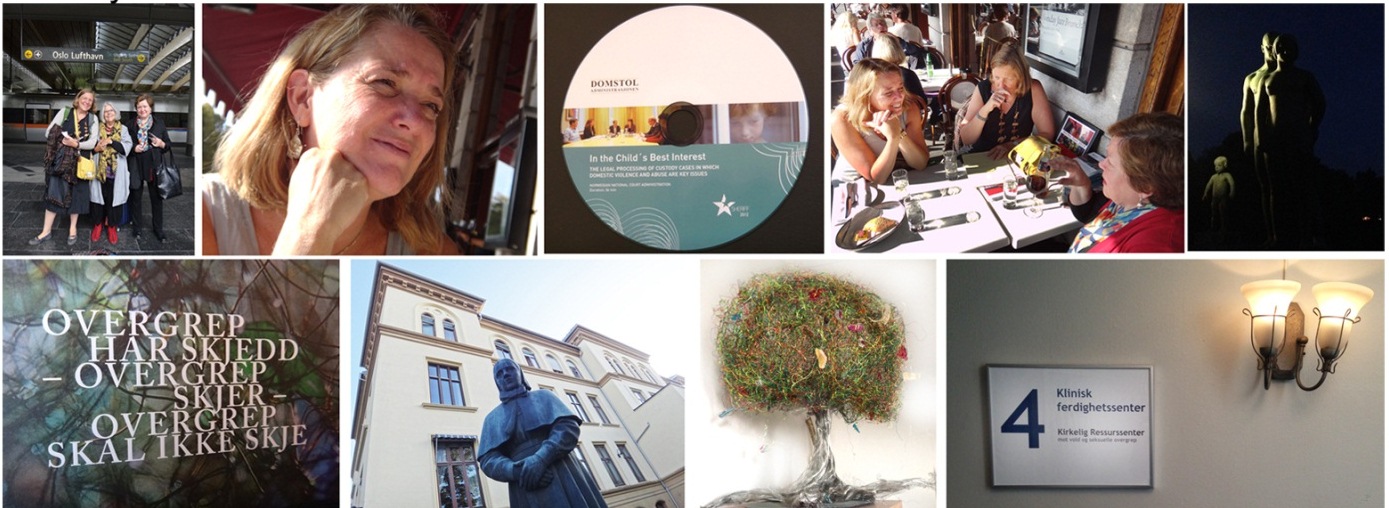Location no. 2 – Oslo 10.09.2014
Hotel Grand in Oslo
___________________________________________________________________________________________

MEETING AND VISIT TO HOSPITAL
Meeting with psychologist in the Court Administration Judith van der Weele. Judith van der Weele and Stig Thorsteinson have helped the Norwegian Court Administration produce the educational movie “Child’s Best Interests – The legal processing of custody cases in which domestic violence and abuse are key issues” together with some written material.
Furthermore, the two psychologist have organised a course that teaches the Norwegian courts.
This is the introduction to the film, that can be found on DVD:
“Domestic violence and allegations of abuse pose challenges in cases concerning Child Welfare.
This concerns violence and abuse suffered by children as well as domestic violence between the children’s parents or care givers which affects these children. Domestic violence and abuse can be difficult to determine. Equally it is hard to assess the influence these issues should have on a given case.
The target groups for this film are judges, solicitors and psychologists who act as expert witnesses. The purpose of the film is to supply relevant psychological expertise and to contribute to an increased understanding of what constitutes good practice between the involved parties, it is underpinned throughout by the cases’ focus always being to meet the child’s best interests.“
The feature article by attorney, specializing in children’s rights, Thea W. Totland, “The children without legal rights – children exposed to abuse don’t get basic procedural rights”, printed in the Norwegian newspaper “Dagbladet”, was discussed and put into perspective.
Visit to Lovisenberg Diaconal Hospital
that has a department for those exposed to abuse. Here we saw the facilities and learned about the professional treatment philosophy within the hospital. The department also focuses on how professionals are affected by the work. This is apparent from the following text:
“For the last 20 years we have also gained a better insight into people’s experience with violence and sexual abuse from entrusted caregivers.
The meeting with other people’s traumatic experiences with violence and sexual abuse can have a strong impact and result in oneself carrying some of the symptoms and obtaining a secondhand trauma. Becoming burned-out is also a part of the issue. Both secondhand trauma and being burned-out can be prevented.
We want to establish solidarity, respect and understanding for the individual experiences and build a network across the church communities and the churches where the individuals have their bases.
Professionals from different professional backgrounds are invited to contribute to the church work with the necessary knowledge, approaches and solutions that could help the continued efforts of the church workers.”
In Norway, the press has highlighted the murders of women by their partners and ex-partners.
In the book “Convention on the Rights of the Child, Children’s Rights in Norway” from Universitetsforlaget 2012, 2nd edition by Njål Høstmælingen, Elin Saga Kjørholt and Kirsten Sandberg (eds.), Trude Haugli writes in chapter 3, regarding the principle of “The Child’s Best Interests”:
“Even though it is extraordinary that almost all of the nations of the world support the child’s best interest as a fundamental consideration regarding all actions that concern children, the principle has also received criticism.
A central question is whether the fundamental need for the principle disappears when the Convention recognises children’s rights, not just their interests.
What a child’s best interests are is not defined in article 3 and is not further defined anywhere else in the Convention. Neither has the Committee established criteria for evaluating whether the states are implementing the principle. If it is used in a way that is too general and with an indeterminate content, there is a risk that the principle becomes so open to interpretation that it becomes optional and thereby loses it’s value (…) (read more)“

